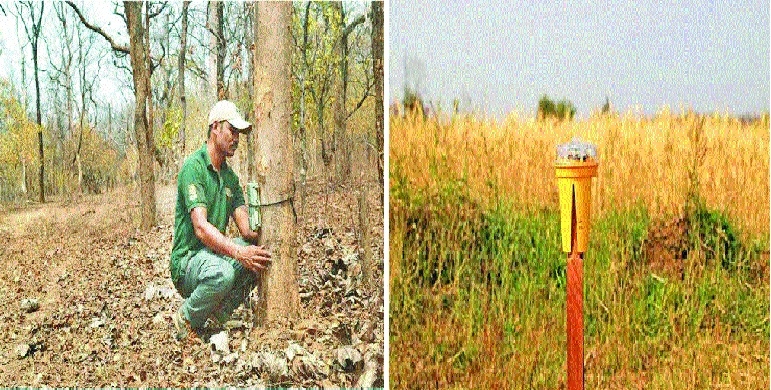Handling human-wildlife conflict through social interventions
| Date :28-Jul-2019 |

By Kartik Lokhande
Enlightening a community is the best way to reduce conflict. When it comes to managing the human-wildlife conflict, making the local community aware about various finer issues involved, can bring about a positive change. This is precisely what Maharashtra Village Social Transformation Foundation (MVSTF) and Wildlife Conservation Trust (WCT) have been doing in Chandrapur district.
MVSTF and WCT have been working on the project for two years. Ahead of the International Tiger Day (celebrated on July 29), they released a report on the current scenario of human-wildlife conflict and work done in last two years. An initiative of Government of Maharashtra, MVSTF was set up with support from leading corporates, with an aim to create a public-private partnership to aid holistic development in rural Maharashtra. Its objective is to integrate multiple developmental goals -- including skill training, education, water security, and environment protection in over 1,000 villages in a way that is ‘scalable, sustainable, and self-enforcing’.
WCT partnered with MVSTF to provide technical inputs to 49 villages in Brahmapuri sub-division of Chandrapur district. These villages are critical from the perspective of forest and wildlife conservation. WCT and MVSTF signed a memorandum of understanding for a collaborative effort to contribute to holistic development of these 49 villages under 21 Gram Panchayats in Nagbhid and Chimur tehsils in Chandrapur district, with special emphasis on human-wildlife interface management as these villages are surrounded with forests and wildlife.
Currently, villages under nine Gram Panchayats have been allocated Chief Minister’s Rural Development Fellow (CMRDF). These villages have characteristic features -- large complex landscape of multi-use areas, large ranging carnivores, forest-dependent communities, human-wildlife conflict, anthropogenic pressures on forests and varying hydro-sheds. Looking at the nature of the project, WCT took an inter-disciplinary approach. It focussed on four aspects -- conservation research, conservation behavior, livelihoods, and education.
WCT in partnership with MVSTF installed alert system in 21 villages on pilot basis to reduce human-wildlife encounters, conducted field trials with foxlights to reduce crop depredation by herbivores. Also, WCT conducted workshops for CMRDFs on introduction to Greater Tadoba landscape, challenges with respect to wildlife and communities, and on public biodiversity registers. Besides, it conducted rapid ethnographic assessment to understand water usage and heating practices in selected villages, and analysed economic and psycho-social data collected from the villages to understand firewood usage patterns.
Crop depredation by wild boars, Sambar, spotted deer, Nilgai, Gaur etc is a major problem faced by farmers in these villages. The landscape has seven types of herbivore presence -- wild boar, gaurs, Nilgai, Sambar, Chital, four-horned antelope, and Muntjac who raid crops during the night. Wild boars are perceived to be the most notorious and highly destructive towards crops and are also known to be aggressive towards humans. Also, Tiger tends to follow these animals which might cause a conflict.
Anish Andheria, President, Wildlife Conservation Trust, shed more light on the work done. He told ‘The Hitavada’ that the entire exercise focussed around making the local population aware of the issues involved and thereby help in reducing human-wildlife conflict. The field trials of foxlights has yielded some results. Foxlights are ‘predator-deterrent lights’ for night predators. They create perception of someone flashing a flashlight. The random patterns cause confusion in the predator resulting into it avoiding coming towards the farm.
The field trials were conducted in MVSTF villages namely Kacchepar, Nanded, Kawdashi, and Lawari on four different crop types. Foxlights were set up in a farm adjoining the forest with the land owner’s consent. As per the MVSTF document, in each of the deployment incidents, farmers reported reduction in instances of raiding by wild boars in their farms. However, a conjunction of alternatives that target other senses like smell and sound along with the lights will also be tried on to further minimise the attacks.
“We have done it at a few places and we wish to use foxlights at some more places,” Andheria said. Apart from foxlights, camera traps are being used to capture images of the wild animals. The images are studied and if there is frequency in presence of an animal like leopard in a particular area near a village, the villagers are alerted and advised to avoid going to that particular spot. The information regarding movement of a carnivore is passed on to the respective Forest Guards and the Range Forest Officers. This reduces the risk of human-wildlife conflict, he added.
Though the results are positive, WCT and MVSTF aim at furthering the cause. According to Andheria, one or two locals from every village, depending upon size of the village, will be selected and trained as Green Guards. They will alert the villagers about presence of an animal in an area, talk to them on issues concerning human-wildlife conflict, strike a dialogue with the locals, estimate the damage caused by wild animals to crop in farm, prepare an authentic report etc. “The idea is to select the people, who the villagers listen to and co-operate. If a community is aware, it can contribute more positively towards effective tackling of human-wildlife conflict,” he said.
Of course, there is more in the offing because as one understands a community some more issues crop up that need attention. For instance, as per the second half-yearly report of WCT for the year 2018-19, data collected from the selected villages showed that usage of firewood for water heating was ‘unaffected’ by current Government programmes. After identifying this issue, which has potential for human-wildlife conflict, WCT is preparing recommendations to the Government for achieving ‘zero dependence’ on firewood.
MVSTF and WCT both are working together to not only identify the issues but also ways and means to resolve those by involving the local community. In sum, an effort is being made to effectively handle human-wildlife conflict through social interventions.